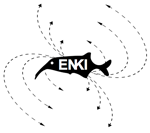![]()
 |
ENKi
Technology Experimental Bio-interfacing +44 (0) 7816 163 921 | info@enkitechnology.net |

![]() Bio-interface
Bio-interface
ENKI exploits several natural physical human responses
to sound light and translates these into signals the fish can relate to.
The human, under the effect of these stimuli returns information back to
the computer and the fish through a system of ‘biofeedback'; either
GSR (Galvanic Skin Response) or/and neurofeedback back via an IBVA [ ![]() ].
It also uses direct electrical connections to the fish.
].
It also uses direct electrical connections to the fish.
In experiments the human participant wears a combination of headphones
and ‘Light Frames’ (used to expose the eyes to controlled bursts
of light) so immersing the human test subject for 15-30 min's in controlled
light and sound. This has the effect of intense psychedelic experience.
Later experiments use sound stimuli only.

Although the specific technology used is only a little different to the
early electronic ‘mind machines’ of the 70s, the difference
is that the fish is in control of any sound and light the human is exposed
to. 'Mind machines' use sound ('binaural beats') and light, to induce
deep states of relaxation, concentration or altered states of consciousness;
mind states traditionally associated with meditation, and shamanic exploration.
The process exploits what is known as ‘brainwave synchronization’ or ‘entrainment’.
This uses the brains 'frequency following' response while listening to
binaural frequencies. These are commonly believed to have psychological
and physiological effects.
 |
|
ENKI
interface - Schematic diagram to show methods of interaction
and communication between electric fish and humans. Central
to this set up is capture of live electrical organ discharge
'EOD' from the electric fish; analysis and replay of simulated
EOD signals
to
the fish. In this case two electric fish are isolated from each
other. Controlled communication between them is made through electrical
connection across the tanks. (Creating the Binaural EOD frequency)
Using this method - we can plug into this connection creating an
'electrical image' between tanks using the human body for example. |
 |
|
Electrode
placement for hypothetical treatment based on electro acupuncture
treatments and enki technology. In the earlier ENKI experiments reference was taken form the ancient art of acupuncture. Here we find a readily prepared body schematic apparently based on subtle energy flows through the body. For purposes of the experiment we assume that these so called energies are based on subtle and electrical fields that propagate through the body, or an ambient field of a bioelectrical nature. The human body can be considered not only as a material with electrical resistive qualities; but also with "capacitive" & "dielectric" properties.  Sensor electrodes placed at the wrist, allow the fish to interact with the human body as an 'electrical image'. This is the term we use when we talk about the way Electrogenic fish 'see' the world and objects. |
Binaural
Beats and Brain Waves
The Black-ghost Knife-fish generate 410 - 440Hz EOD frequency, in the
Millivolt range. When interacting with the ENKI system or each other
they naturally begin to modulate these frequencies communicating with
small modulations called ‘chirps’. They create a binaural
frequency of 4-20Hz. Theoretically by listening to this binaural tone,
our brain could sync with the frequency modulations of the fish.
Brain Waves Hz
Beta Waves 14-100 Hz: Awake state, eyes open, alert focusing.
Alpha Waves 8 to 13 Hz: Closed eyes, relaxed, passive, or unfocused.
Theta Waves. 4 to 8 Hz: Calm and deeply relaxed and dreaming.
Delta Waves 0.5 - 3.5Hz: Deep sleep.
Central to the ENKI system is capture of live electrical signals from
the fish, analysis and replay of simulated signals back to the fish.
Controlled communication between the fish is made through the ENKI system
via electrical connections across the tanks, this creates an 'electrical
image' using the biophysical properties of the human body. The investigation
looks at how this affects the behavior of the fish and if it is possible
to create a biofeedback loop based on intercommunication brain states
and biophysical states, between species.

Measurement & observation
To measure the effect this process has on the human test subject an EEG
monitor or neuro-graphic interface [the IBVA] is used. In theory through
analyzing the frequencies generated by the fish we should see a synchronous
relationship in the brain-wave data. This however is notoriously difficult
to intemperate. As well as the graphics data obtained, the behavior
and particular chirping activity of the fish must be taken into account.
In
later experiment we used a GSR sensor as a means to detect the emotional
response the stimulus.
MUIO
- MAX MSP, early sensor interface  (Above) This
is the muio interface (Above) This
is the muio interface (Above) Connected with LDR's as light sensors used to monitor fish movement in tank.  (Above) The Lab at CNRS...  (Above) muio interface board and fish. |
|
The
ENKI interface is an experiment which aims to discover;
|
 |
 |
|
 |



